HLTENN013 Implement and Monitor Care for Older People Assignment
VerifiedAdded on 2021/04/16
|23
|4988
|98
Homework Assignment
AI Summary
This document presents a detailed solution to a nursing assignment focused on the care of older people, addressing several key areas. The assignment begins by exploring stereotypes associated with aging and their impact, followed by strategies for promoting health maintenance, including lifestyle factors and community resources, with a case study involving a diabetic patient. It then delves into elder abuse, defining its forms, legal requirements, ethical considerations, and warning signs. The solution further analyzes non-pharmacological therapies for dementia, outlines the normal aging process, and describes biological and psychosocial theories of aging, including disengagement and social exchange theories. The assignment also covers the care of deceased individuals, including the stages of grief and strategies for supporting grieving families. Additionally, it identifies physical, emotional, and mental signs of stress and appropriate responses, and concludes by examining the limitations and legal ramifications of patient restraints. This comprehensive solution provides valuable insights for nursing students studying aged care.
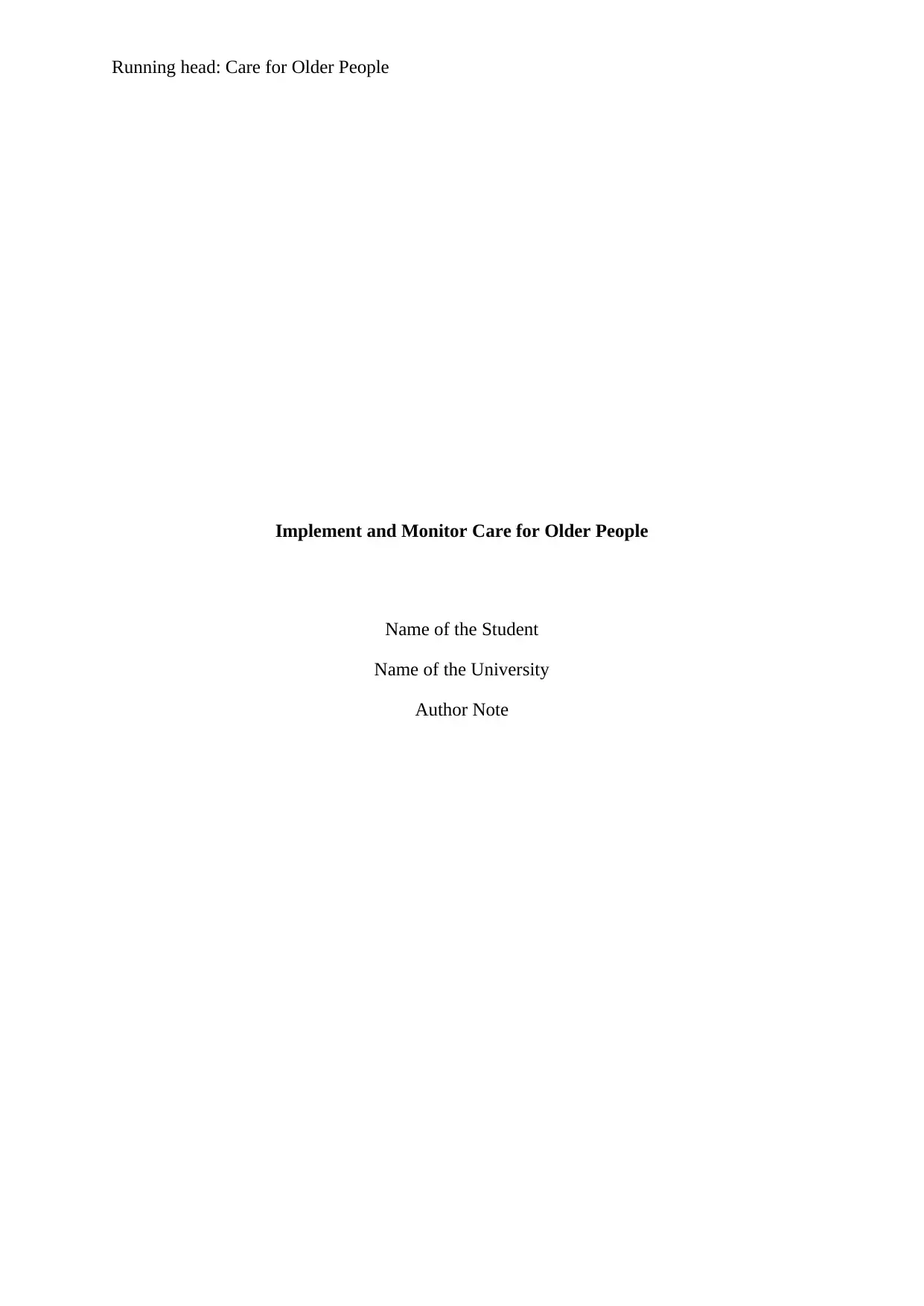
Running head: Care for Older People
Implement and Monitor Care for Older People
Name of the Student
Name of the University
Author Note
Implement and Monitor Care for Older People
Name of the Student
Name of the University
Author Note
Paraphrase This Document
Need a fresh take? Get an instant paraphrase of this document with our AI Paraphraser
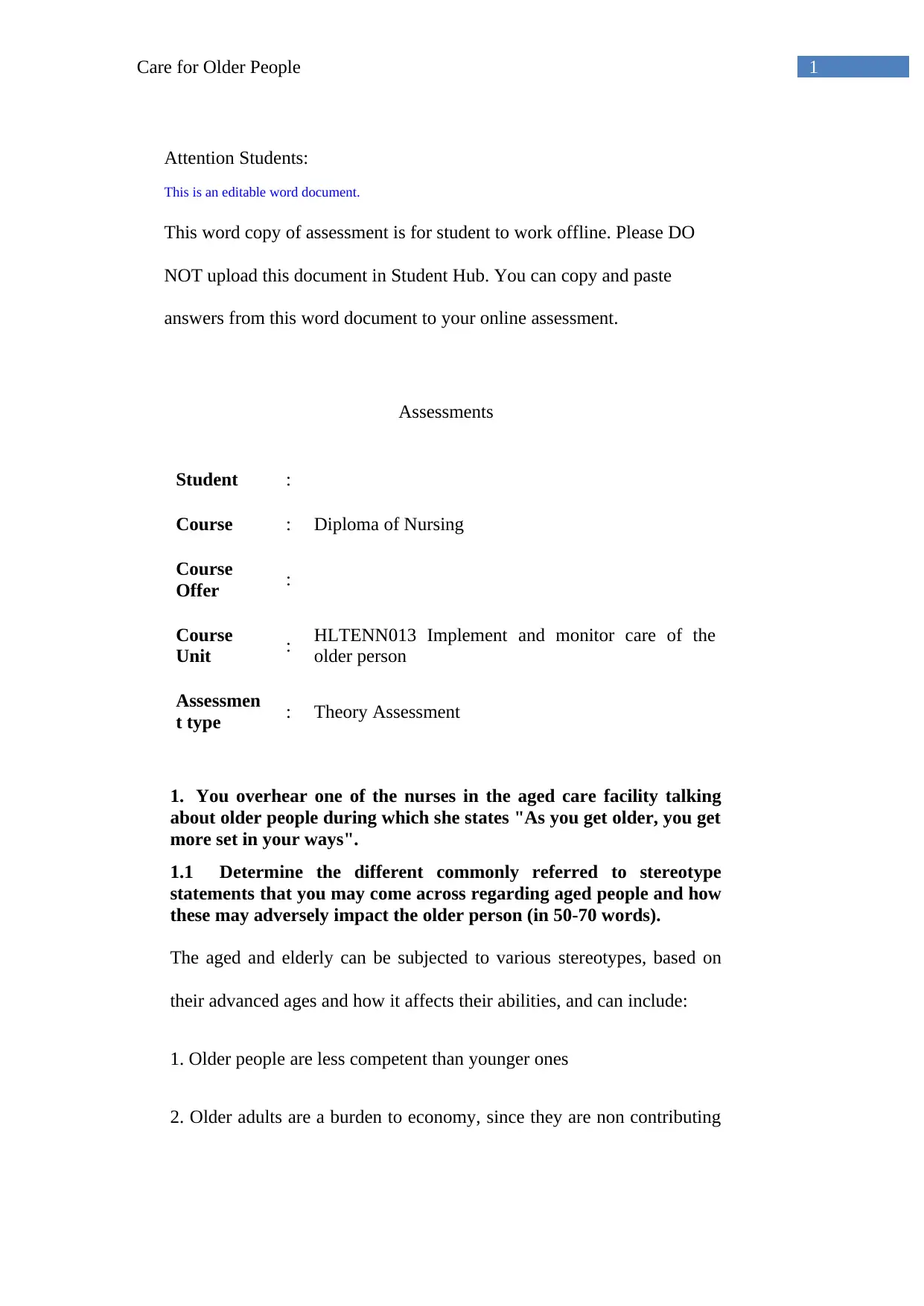
1Care for Older People
Attention Students:
This is an editable word document.
This word copy of assessment is for student to work offline. Please DO
NOT upload this document in Student Hub. You can copy and paste
answers from this word document to your online assessment.
Assessments
Student :
Course : Diploma of Nursing
Course
Offer :
Course
Unit : HLTENN013 Implement and monitor care of the
older person
Assessmen
t type : Theory Assessment
1. You overhear one of the nurses in the aged care facility talking
about older people during which she states "As you get older, you get
more set in your ways".
1.1 Determine the different commonly referred to stereotype
statements that you may come across regarding aged people and how
these may adversely impact the older person (in 50-70 words).
The aged and elderly can be subjected to various stereotypes, based on
their advanced ages and how it affects their abilities, and can include:
1. Older people are less competent than younger ones
2. Older adults are a burden to economy, since they are non contributing
Attention Students:
This is an editable word document.
This word copy of assessment is for student to work offline. Please DO
NOT upload this document in Student Hub. You can copy and paste
answers from this word document to your online assessment.
Assessments
Student :
Course : Diploma of Nursing
Course
Offer :
Course
Unit : HLTENN013 Implement and monitor care of the
older person
Assessmen
t type : Theory Assessment
1. You overhear one of the nurses in the aged care facility talking
about older people during which she states "As you get older, you get
more set in your ways".
1.1 Determine the different commonly referred to stereotype
statements that you may come across regarding aged people and how
these may adversely impact the older person (in 50-70 words).
The aged and elderly can be subjected to various stereotypes, based on
their advanced ages and how it affects their abilities, and can include:
1. Older people are less competent than younger ones
2. Older adults are a burden to economy, since they are non contributing
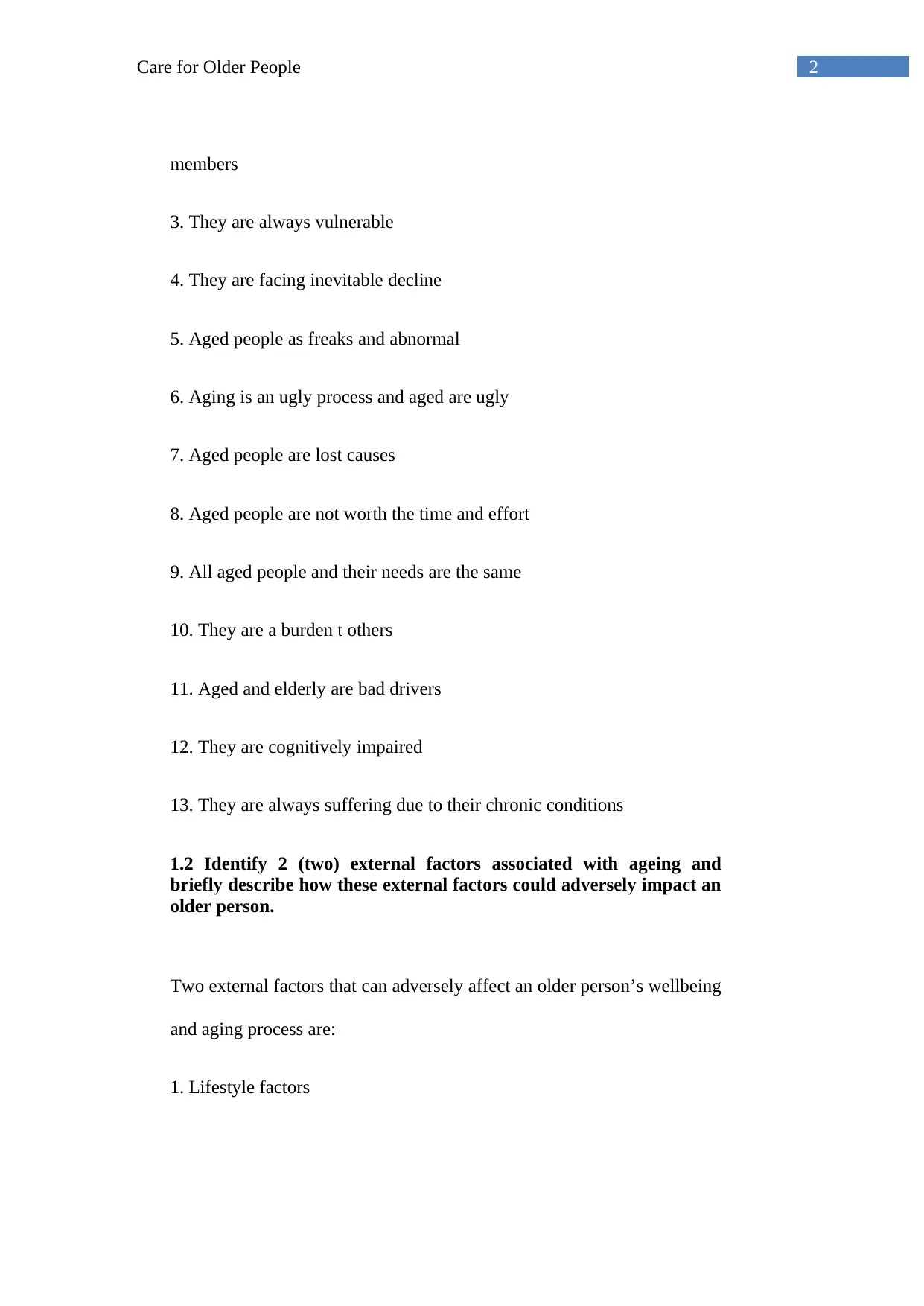
2Care for Older People
members
3. They are always vulnerable
4. They are facing inevitable decline
5. Aged people as freaks and abnormal
6. Aging is an ugly process and aged are ugly
7. Aged people are lost causes
8. Aged people are not worth the time and effort
9. All aged people and their needs are the same
10. They are a burden t others
11. Aged and elderly are bad drivers
12. They are cognitively impaired
13. They are always suffering due to their chronic conditions
1.2 Identify 2 (two) external factors associated with ageing and
briefly describe how these external factors could adversely impact an
older person.
Two external factors that can adversely affect an older person’s wellbeing
and aging process are:
1. Lifestyle factors
members
3. They are always vulnerable
4. They are facing inevitable decline
5. Aged people as freaks and abnormal
6. Aging is an ugly process and aged are ugly
7. Aged people are lost causes
8. Aged people are not worth the time and effort
9. All aged people and their needs are the same
10. They are a burden t others
11. Aged and elderly are bad drivers
12. They are cognitively impaired
13. They are always suffering due to their chronic conditions
1.2 Identify 2 (two) external factors associated with ageing and
briefly describe how these external factors could adversely impact an
older person.
Two external factors that can adversely affect an older person’s wellbeing
and aging process are:
1. Lifestyle factors
⊘ This is a preview!⊘
Do you want full access?
Subscribe today to unlock all pages.

Trusted by 1+ million students worldwide

3Care for Older People
2. Environmental stressors
2. Imagine that you are working with Kevin Mills, 78 years old, who
lives alone in an independent living unit. Mills has type 1 diabetes.
You visited Mills today to check his blood sugar and ensure that he
maintains his health in his best possible way in relation to the agreed
NCP. Mills' daughter is at home now and she visits Mills two days a
week to ensure his welfare.
2.1 Mills' blood sugar is 10.2mmol/L at 10:00 am. He had his
breakfast at 08:30am (2 toast, raspberry jam and tea with two
sugars). Mills stated that he did not document the previous blood
sugar values and doesn't want to follow the diabetic diet plan as he
feels the diabetic diet is 'boring'. Provide 2 (two) examples of
strategies you would implement as a nurse in promoting the health
maintenance of Mills.
To promote the health and wellbeing of the patient, two strategies that
can be recommended includes:
1. Increasing the physical activity and involving daily physical exercise
for improving endurance and strength
2. Medication, compliance and follow-up
2.2 Identify and describe a community service/resource Mills and his
daughter could access in promoting his health maintenance in
relation to the identified issue in addition to the home nursing
services.
The different community services and resources that the patient can
access to promote the health and wellbeing includes:
a) Social service
2. Environmental stressors
2. Imagine that you are working with Kevin Mills, 78 years old, who
lives alone in an independent living unit. Mills has type 1 diabetes.
You visited Mills today to check his blood sugar and ensure that he
maintains his health in his best possible way in relation to the agreed
NCP. Mills' daughter is at home now and she visits Mills two days a
week to ensure his welfare.
2.1 Mills' blood sugar is 10.2mmol/L at 10:00 am. He had his
breakfast at 08:30am (2 toast, raspberry jam and tea with two
sugars). Mills stated that he did not document the previous blood
sugar values and doesn't want to follow the diabetic diet plan as he
feels the diabetic diet is 'boring'. Provide 2 (two) examples of
strategies you would implement as a nurse in promoting the health
maintenance of Mills.
To promote the health and wellbeing of the patient, two strategies that
can be recommended includes:
1. Increasing the physical activity and involving daily physical exercise
for improving endurance and strength
2. Medication, compliance and follow-up
2.2 Identify and describe a community service/resource Mills and his
daughter could access in promoting his health maintenance in
relation to the identified issue in addition to the home nursing
services.
The different community services and resources that the patient can
access to promote the health and wellbeing includes:
a) Social service
Paraphrase This Document
Need a fresh take? Get an instant paraphrase of this document with our AI Paraphraser
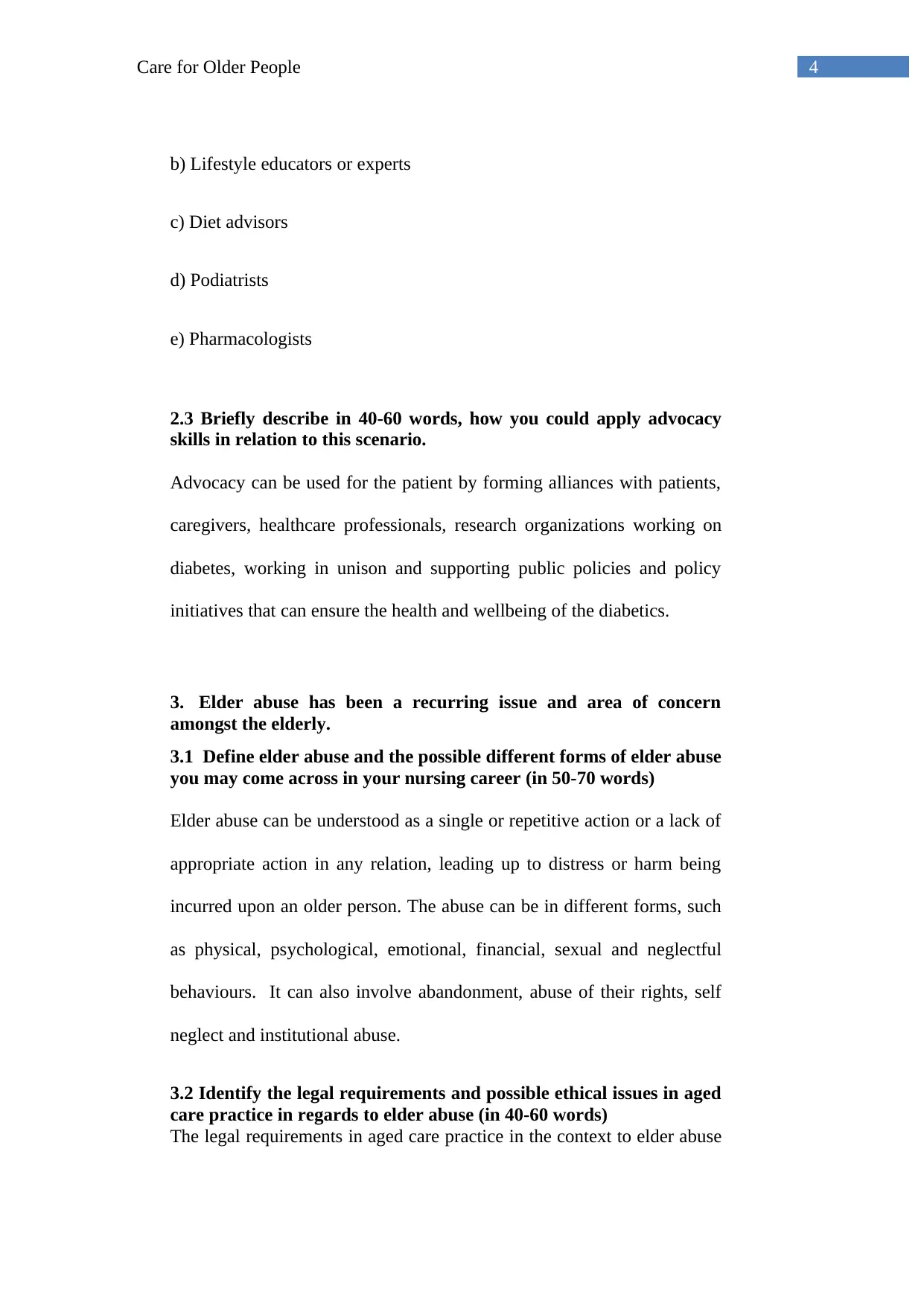
4Care for Older People
b) Lifestyle educators or experts
c) Diet advisors
d) Podiatrists
e) Pharmacologists
2.3 Briefly describe in 40-60 words, how you could apply advocacy
skills in relation to this scenario.
Advocacy can be used for the patient by forming alliances with patients,
caregivers, healthcare professionals, research organizations working on
diabetes, working in unison and supporting public policies and policy
initiatives that can ensure the health and wellbeing of the diabetics.
3. Elder abuse has been a recurring issue and area of concern
amongst the elderly.
3.1 Define elder abuse and the possible different forms of elder abuse
you may come across in your nursing career (in 50-70 words)
Elder abuse can be understood as a single or repetitive action or a lack of
appropriate action in any relation, leading up to distress or harm being
incurred upon an older person. The abuse can be in different forms, such
as physical, psychological, emotional, financial, sexual and neglectful
behaviours. It can also involve abandonment, abuse of their rights, self
neglect and institutional abuse.
3.2 Identify the legal requirements and possible ethical issues in aged
care practice in regards to elder abuse (in 40-60 words)
The legal requirements in aged care practice in the context to elder abuse
b) Lifestyle educators or experts
c) Diet advisors
d) Podiatrists
e) Pharmacologists
2.3 Briefly describe in 40-60 words, how you could apply advocacy
skills in relation to this scenario.
Advocacy can be used for the patient by forming alliances with patients,
caregivers, healthcare professionals, research organizations working on
diabetes, working in unison and supporting public policies and policy
initiatives that can ensure the health and wellbeing of the diabetics.
3. Elder abuse has been a recurring issue and area of concern
amongst the elderly.
3.1 Define elder abuse and the possible different forms of elder abuse
you may come across in your nursing career (in 50-70 words)
Elder abuse can be understood as a single or repetitive action or a lack of
appropriate action in any relation, leading up to distress or harm being
incurred upon an older person. The abuse can be in different forms, such
as physical, psychological, emotional, financial, sexual and neglectful
behaviours. It can also involve abandonment, abuse of their rights, self
neglect and institutional abuse.
3.2 Identify the legal requirements and possible ethical issues in aged
care practice in regards to elder abuse (in 40-60 words)
The legal requirements in aged care practice in the context to elder abuse

5Care for Older People
include the responsibility of the care providers to ensure the beneficence
and non malefiscience of the patients, supporting their autonomy, legal
and judicial rights.
The ethical issues challenges that can be related to this context includes:
the conflict between duty to report incidents and the autonomy of the
victim, the right of self determination of the victim versus their safety and
protection and choosing between least restrictive alternatives versus
safety and protection.
3.3 List 4 (four) possible signs of elder abuse.
Four warning signs that can indicate potential elder abuse includes:
a) Physical signs such as unexplained signs of injuries, bruise or scares,
broken bones, sprains or other types of injury
b) Emotional signs of abuse such as fear, anxiety, and symptoms that
mimic dementia
c) Sexual abuse signs such as bruises around genitals, torn underclothing
d) Signs of neglect, such as malnutrition and unusual weight loss,
untreated physical problems, unsanitary living conditions, improper
clothing, unsafe living conditions and deserted elder people in a public
place.
4. Analyse possible non-pharmacological therapies used in the
include the responsibility of the care providers to ensure the beneficence
and non malefiscience of the patients, supporting their autonomy, legal
and judicial rights.
The ethical issues challenges that can be related to this context includes:
the conflict between duty to report incidents and the autonomy of the
victim, the right of self determination of the victim versus their safety and
protection and choosing between least restrictive alternatives versus
safety and protection.
3.3 List 4 (four) possible signs of elder abuse.
Four warning signs that can indicate potential elder abuse includes:
a) Physical signs such as unexplained signs of injuries, bruise or scares,
broken bones, sprains or other types of injury
b) Emotional signs of abuse such as fear, anxiety, and symptoms that
mimic dementia
c) Sexual abuse signs such as bruises around genitals, torn underclothing
d) Signs of neglect, such as malnutrition and unusual weight loss,
untreated physical problems, unsanitary living conditions, improper
clothing, unsafe living conditions and deserted elder people in a public
place.
4. Analyse possible non-pharmacological therapies used in the
⊘ This is a preview!⊘
Do you want full access?
Subscribe today to unlock all pages.

Trusted by 1+ million students worldwide
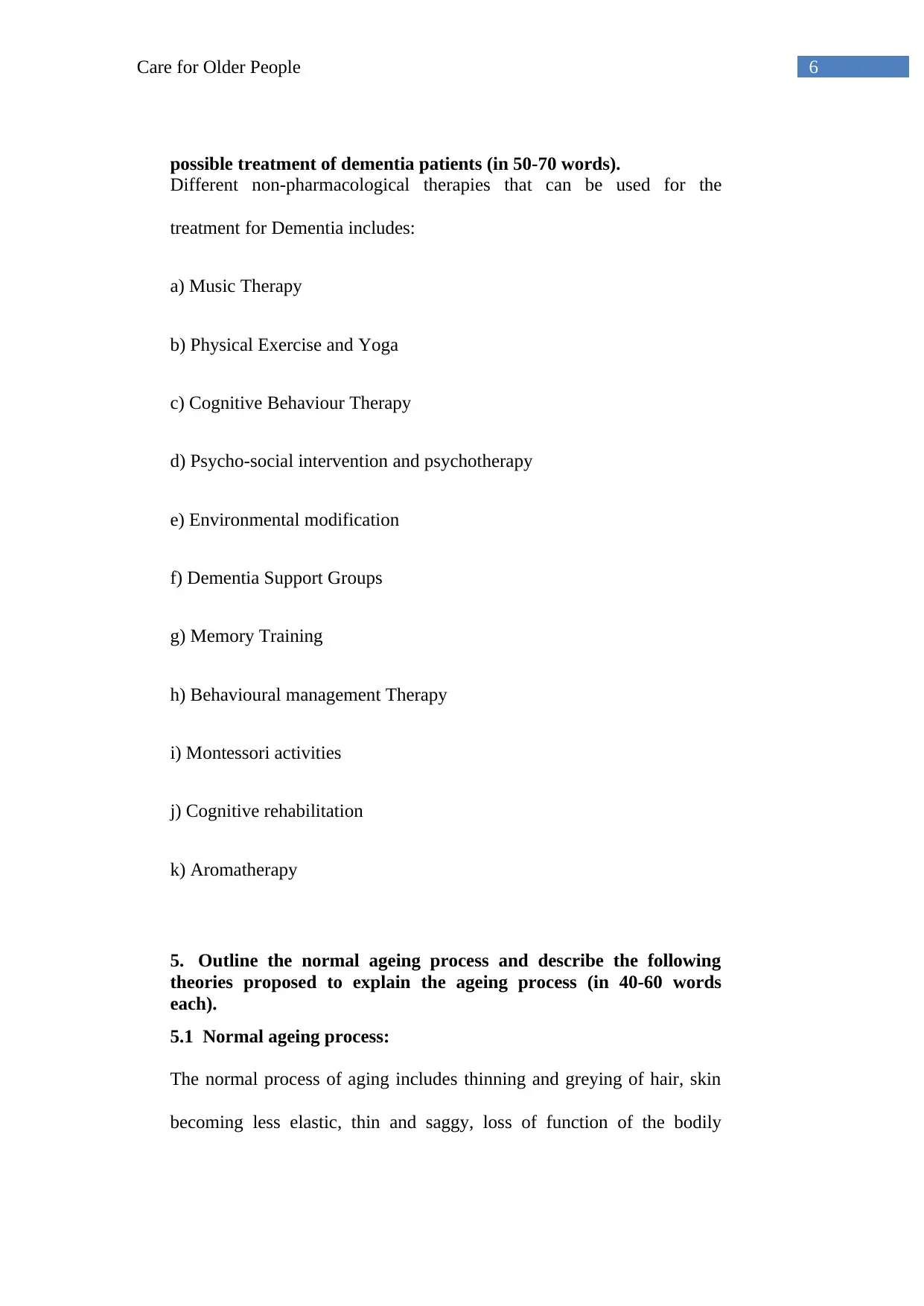
6Care for Older People
possible treatment of dementia patients (in 50-70 words).
Different non-pharmacological therapies that can be used for the
treatment for Dementia includes:
a) Music Therapy
b) Physical Exercise and Yoga
c) Cognitive Behaviour Therapy
d) Psycho-social intervention and psychotherapy
e) Environmental modification
f) Dementia Support Groups
g) Memory Training
h) Behavioural management Therapy
i) Montessori activities
j) Cognitive rehabilitation
k) Aromatherapy
5. Outline the normal ageing process and describe the following
theories proposed to explain the ageing process (in 40-60 words
each).
5.1 Normal ageing process:
The normal process of aging includes thinning and greying of hair, skin
becoming less elastic, thin and saggy, loss of function of the bodily
possible treatment of dementia patients (in 50-70 words).
Different non-pharmacological therapies that can be used for the
treatment for Dementia includes:
a) Music Therapy
b) Physical Exercise and Yoga
c) Cognitive Behaviour Therapy
d) Psycho-social intervention and psychotherapy
e) Environmental modification
f) Dementia Support Groups
g) Memory Training
h) Behavioural management Therapy
i) Montessori activities
j) Cognitive rehabilitation
k) Aromatherapy
5. Outline the normal ageing process and describe the following
theories proposed to explain the ageing process (in 40-60 words
each).
5.1 Normal ageing process:
The normal process of aging includes thinning and greying of hair, skin
becoming less elastic, thin and saggy, loss of function of the bodily
Paraphrase This Document
Need a fresh take? Get an instant paraphrase of this document with our AI Paraphraser
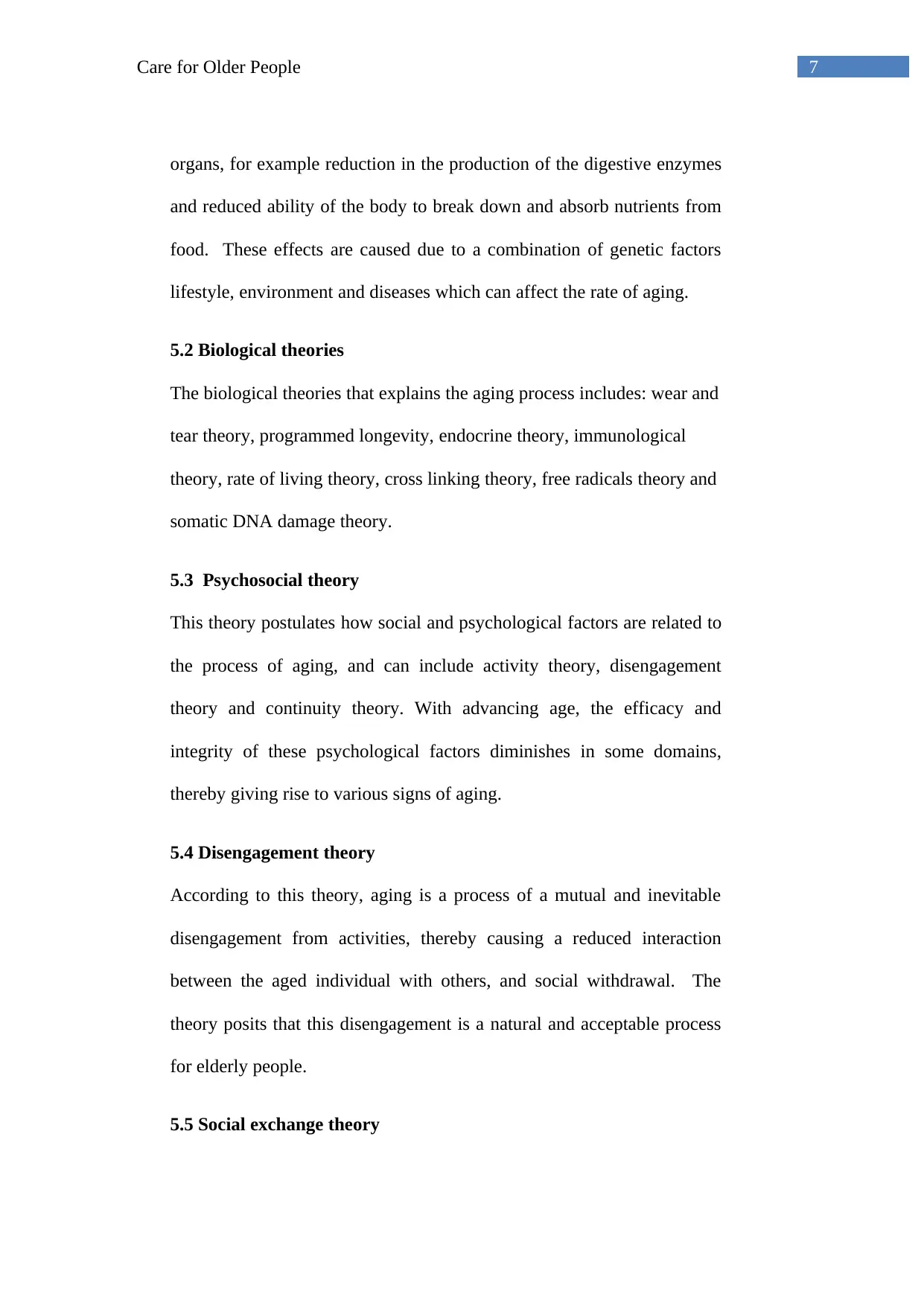
7Care for Older People
organs, for example reduction in the production of the digestive enzymes
and reduced ability of the body to break down and absorb nutrients from
food. These effects are caused due to a combination of genetic factors
lifestyle, environment and diseases which can affect the rate of aging.
5.2 Biological theories
The biological theories that explains the aging process includes: wear and
tear theory, programmed longevity, endocrine theory, immunological
theory, rate of living theory, cross linking theory, free radicals theory and
somatic DNA damage theory.
5.3 Psychosocial theory
This theory postulates how social and psychological factors are related to
the process of aging, and can include activity theory, disengagement
theory and continuity theory. With advancing age, the efficacy and
integrity of these psychological factors diminishes in some domains,
thereby giving rise to various signs of aging.
5.4 Disengagement theory
According to this theory, aging is a process of a mutual and inevitable
disengagement from activities, thereby causing a reduced interaction
between the aged individual with others, and social withdrawal. The
theory posits that this disengagement is a natural and acceptable process
for elderly people.
5.5 Social exchange theory
organs, for example reduction in the production of the digestive enzymes
and reduced ability of the body to break down and absorb nutrients from
food. These effects are caused due to a combination of genetic factors
lifestyle, environment and diseases which can affect the rate of aging.
5.2 Biological theories
The biological theories that explains the aging process includes: wear and
tear theory, programmed longevity, endocrine theory, immunological
theory, rate of living theory, cross linking theory, free radicals theory and
somatic DNA damage theory.
5.3 Psychosocial theory
This theory postulates how social and psychological factors are related to
the process of aging, and can include activity theory, disengagement
theory and continuity theory. With advancing age, the efficacy and
integrity of these psychological factors diminishes in some domains,
thereby giving rise to various signs of aging.
5.4 Disengagement theory
According to this theory, aging is a process of a mutual and inevitable
disengagement from activities, thereby causing a reduced interaction
between the aged individual with others, and social withdrawal. The
theory posits that this disengagement is a natural and acceptable process
for elderly people.
5.5 Social exchange theory

8Care for Older People
This theory proposes that social behaviours is a product of social
interactions and takes into consideration the costs and benefits of a
relation using which it is determined whether a social association should
be continued or not, and that with advancing age, the social exchanges
goes through changes and develops, thereby eliminating many social
associations deemed costly or non-beneficial.
5.6 Wear and tear theory
The Wear and Tear theory suggests that the pronged functioning of the
bodily systems along with reduced healing abilities increases the wear
and tear on the cells and tissues, thereby giving rise to the symptoms and
signs of aging. This can be compared to the wear and tear of machines
with continued use, leading up to its components becoming less effective
and unusable, as is seen in case of degenerative diseases.
5.7 Activity theory
This theory is also called the implicit theory of aging, and proposes that
aging occurs when an individual remains when an individual remains
active and maintains their social interactions. Thus it points out that aging
is caused due to the continued activity and social exchanges between an
individual and the surroundings.
6. Each person reacts to the knowledge of death or loss in their own
way however there are similarities in the psychosocial responses to
This theory proposes that social behaviours is a product of social
interactions and takes into consideration the costs and benefits of a
relation using which it is determined whether a social association should
be continued or not, and that with advancing age, the social exchanges
goes through changes and develops, thereby eliminating many social
associations deemed costly or non-beneficial.
5.6 Wear and tear theory
The Wear and Tear theory suggests that the pronged functioning of the
bodily systems along with reduced healing abilities increases the wear
and tear on the cells and tissues, thereby giving rise to the symptoms and
signs of aging. This can be compared to the wear and tear of machines
with continued use, leading up to its components becoming less effective
and unusable, as is seen in case of degenerative diseases.
5.7 Activity theory
This theory is also called the implicit theory of aging, and proposes that
aging occurs when an individual remains when an individual remains
active and maintains their social interactions. Thus it points out that aging
is caused due to the continued activity and social exchanges between an
individual and the surroundings.
6. Each person reacts to the knowledge of death or loss in their own
way however there are similarities in the psychosocial responses to
⊘ This is a preview!⊘
Do you want full access?
Subscribe today to unlock all pages.

Trusted by 1+ million students worldwide

9Care for Older People
the situation. As a nurse, care of the deceased and providing comfort
to the grieving families is essential in our role and being able to do
these tasks effectively is pivotal.
6.1 Discuss the care of a deceased person (in 80-100 words).
Caring for a deceased patient is an important and sensitive aspect of
nursing, and should include the following aspects:
a) Providing immediate care for the deceased and their families
b) Helping the conduction of specific rituals for the deceased
c) Documenting and handing over of any valuables of the deceased to the
nominated next of kin.
d) Involving social workers and social support
e) Helping with pastoral care
f) Preparing the body for the family to view
g) Transporting body to the mortuary
h) Addressing the coroner’s criteria
i) Taking special precautions to prevent the spread of disease from the
deceased individual
6.2 In order to provide support and comfort to the grieving families
we must be able to identify the grieving process. Identify the stages of
grief and how we may be able to assist the families (in 50-70 words)
According to the Kubler-Ross model, the emotional states that are
experienced by terminally ill patients and by individuals experiencing
the situation. As a nurse, care of the deceased and providing comfort
to the grieving families is essential in our role and being able to do
these tasks effectively is pivotal.
6.1 Discuss the care of a deceased person (in 80-100 words).
Caring for a deceased patient is an important and sensitive aspect of
nursing, and should include the following aspects:
a) Providing immediate care for the deceased and their families
b) Helping the conduction of specific rituals for the deceased
c) Documenting and handing over of any valuables of the deceased to the
nominated next of kin.
d) Involving social workers and social support
e) Helping with pastoral care
f) Preparing the body for the family to view
g) Transporting body to the mortuary
h) Addressing the coroner’s criteria
i) Taking special precautions to prevent the spread of disease from the
deceased individual
6.2 In order to provide support and comfort to the grieving families
we must be able to identify the grieving process. Identify the stages of
grief and how we may be able to assist the families (in 50-70 words)
According to the Kubler-Ross model, the emotional states that are
experienced by terminally ill patients and by individuals experiencing
Paraphrase This Document
Need a fresh take? Get an instant paraphrase of this document with our AI Paraphraser

10Care for Older People
bereavement of their loved ones includes: denial (which is the first
reaction, and involves individuals to believe that the diagnosis is
mistaken), anger (this is the next stage, where the individual realises the
diagnosis is correct, and shows frustration about the diagnosis),
bargaining (at this stage, the individuals are no longer angry, but are
desperate in the hope that the cause of grief can be avoided and a bargain
can be made to extend their life), depression (here the individual comes in
terms with the reality and shows despair over it) and acceptance (at this
stage the individual accepts the reality and is open for steps to prepare for
the eventuality).
7. Each of us handles stress differently however it can diminish your
quality of life if not managed properly. It's important to recognize
the warning signs of stress especially in older clients or clients
diagnosed with dementia or Alzheimer's disease. Identify physical,
emotional and mental signs of stress and how you would respond to
each of these signs (in 30-40 words each)
7.1 Physical:
Physical signs and symptoms of stress can include neck pain, muscular
tension, headache, nausea, hair loss, gain in weight, acne. Insomnia, fast
heartbeats, fatigue, chronic health issues and irregular menstrual cycles
(for women).
7.2 Emotional:
Emotional signs of stress can include depression, unhappiness, anxiety,
agitation, moodiness, irritability, anger, loneliness, isolation, mental and
bereavement of their loved ones includes: denial (which is the first
reaction, and involves individuals to believe that the diagnosis is
mistaken), anger (this is the next stage, where the individual realises the
diagnosis is correct, and shows frustration about the diagnosis),
bargaining (at this stage, the individuals are no longer angry, but are
desperate in the hope that the cause of grief can be avoided and a bargain
can be made to extend their life), depression (here the individual comes in
terms with the reality and shows despair over it) and acceptance (at this
stage the individual accepts the reality and is open for steps to prepare for
the eventuality).
7. Each of us handles stress differently however it can diminish your
quality of life if not managed properly. It's important to recognize
the warning signs of stress especially in older clients or clients
diagnosed with dementia or Alzheimer's disease. Identify physical,
emotional and mental signs of stress and how you would respond to
each of these signs (in 30-40 words each)
7.1 Physical:
Physical signs and symptoms of stress can include neck pain, muscular
tension, headache, nausea, hair loss, gain in weight, acne. Insomnia, fast
heartbeats, fatigue, chronic health issues and irregular menstrual cycles
(for women).
7.2 Emotional:
Emotional signs of stress can include depression, unhappiness, anxiety,
agitation, moodiness, irritability, anger, loneliness, isolation, mental and

11Care for Older People
emotional health problems.
7.3 Mental:
Mental signs of stress can include memory problems, inability to pay
attention and lack of focus or concentration, poor sense of judgement,
pessimistic approach, constant worrying and also signs of mental health
deterioration.
8. The medical practitioner providing the patient's care is ultimately
responsible for the decision to restrain a patient. However, the
decision to use restraints should not occur in isolation. It involves a
process of request, assessment, team involvement and consent within
an ethical and legal framework. A restraint is a device or medication
that is administered for the purpose of restricting the movement
and/or behavior of a person.
Determine the limitations and legal ramifications of the following
forms of restraint (in 40-60 words each):
8.1 Physical
While using physical restraints, information such as what type of
restraints are being used, how long the use should be maintained, and
ensuring constant monitoring of the patient while in restrained by a
certified professional are necessary, as well as justifying the use of need,
and also ensuring that the restraint is not used unnecessarily and only for
the shortest amount of time.
8.2 Chemical
Using chemical restraint also has to outline the type of chemical being
used; it’s adverse or side effects being made known to the patient or their
emotional health problems.
7.3 Mental:
Mental signs of stress can include memory problems, inability to pay
attention and lack of focus or concentration, poor sense of judgement,
pessimistic approach, constant worrying and also signs of mental health
deterioration.
8. The medical practitioner providing the patient's care is ultimately
responsible for the decision to restrain a patient. However, the
decision to use restraints should not occur in isolation. It involves a
process of request, assessment, team involvement and consent within
an ethical and legal framework. A restraint is a device or medication
that is administered for the purpose of restricting the movement
and/or behavior of a person.
Determine the limitations and legal ramifications of the following
forms of restraint (in 40-60 words each):
8.1 Physical
While using physical restraints, information such as what type of
restraints are being used, how long the use should be maintained, and
ensuring constant monitoring of the patient while in restrained by a
certified professional are necessary, as well as justifying the use of need,
and also ensuring that the restraint is not used unnecessarily and only for
the shortest amount of time.
8.2 Chemical
Using chemical restraint also has to outline the type of chemical being
used; it’s adverse or side effects being made known to the patient or their
⊘ This is a preview!⊘
Do you want full access?
Subscribe today to unlock all pages.

Trusted by 1+ million students worldwide
1 out of 23
Related Documents
Your All-in-One AI-Powered Toolkit for Academic Success.
+13062052269
info@desklib.com
Available 24*7 on WhatsApp / Email
![[object Object]](/_next/static/media/star-bottom.7253800d.svg)
Unlock your academic potential
Copyright © 2020–2025 A2Z Services. All Rights Reserved. Developed and managed by ZUCOL.





